CHAR Bar And Grill Only Restaurant In Shanghai Serving Blackmore's Wagyu Australian Beef#
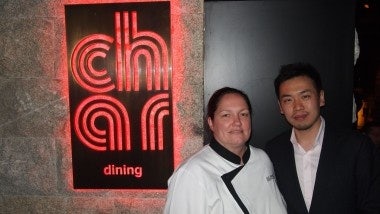
CHAR's Executive Chef, Julie Donohoe and Food and Beverage Director, Ethan Tian (Photo by Rex Jiang for Jing Daily)
Perched atop the Hotel Indigo on the Bund, CHAR is the newest in the ever-growing Shanghai restaurant scene. Focusing on premium-quality beef and seafood, CHAR is currently the only restaurant in China that imports Blackmore's Wagyu beef from Australia, complementing its menu with fresh local produce. CHAR's sophisticated interior, designed by Hirsch Bedner Associates, features a fine dining area, open grill kitchen, wine and cocktail lounge, two terraces, and three private dining rooms.
Executive Chef Julie Donohoe expertly applies her Australian training to CHAR's menu, particularly in dishes like its signature "Char Indulgence," which highlights the quality of Blackmore's Wagyu, raised for 600 days using traditional Japanese methods. Among Shanghai's steadily increasing number of steakhouses, CHAR is also unique in presenting touches such as a selection of handcrafted steak knives, as well as paintbrushes for applying sauces and selection of exotic salts.
Complimenting the fine dining experience is an extensive wine and cocktail list, designed by Food and Beverage Director and certified sommelier Ethan Tian.
Jing Daily sat down with Tian and chef Julie Donohoe to discuss their vision for CHAR, its grand opening, and their ideas about appealing to Chinese tastes.
Jing Daily (JD): This question's directed to you, Julie. Many of the ingredients featured in your dishes are less common in Chinese cuisine. How much education or adaptation do you foresee for the Chinese market? At least for the Chinese palate.#
Chef Julie Donohoe:#
I think the Chinese are becoming a lot more adventurous and want to try different things. I’ve only been here 12 months but already I can see they want to. If I do a set menu like this for you - you might not order it otherwise, but if you try it with all the different flavors, you go, “Oh, actually, I was a bit scared at first but now that I’ve tried it, I really like it.” So I think it’s just trying to encourage local diners, which we’re doing a lot of set menus, where I’m trying to use things that they may not be used to, to understand, and to help them to taste the flavors.
JD: I mean, you use a lot of sweet flavors, a lot of salty-sweet, fruits...#
Julie:#
Yeah, I have a little bit of an Asian-cooking background. In Australia, we always do a lot of fusion food. So I’m used to trying to do this with the food at CHAR, like the cod sauce with currants.
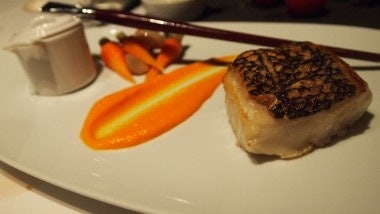
JD: Yeah, I really enjoyed that. So what’s the idea behind the paintbrush thing? To get people involved?#
Julie:#
Just to make it a little more fun, yeah. Also, the idea is that you can put as little or as much sauce as you'd like.
JD: What are some differences in dining culture between Westerners and Chinese? There’s obviously an emphasis on service and atmosphere here, but did you do anything special to cater to Chinese guests?#
Julie:#
I’ve been doing a lot of research on trying different tasting menus, and we actually have about six different types of set menus. So again, to make Chinese guests feel more comfortable, there are differently priced menus, ranging from 400 RMB to 1,800 RMB (US$61-$277). So depending if they want to spend a lot of money on their family and friends or [not], I match the food together and Ethan will match the wine. They can come in and just sit down, not have to think, we just look after them. I think this is probably more their style.
Also the sharing, there's a little more sharing, instead of just a la carte. Again this is something Chinese customers are accustomed to, and feel a bit more comfortable with.
JD: Alright, Ethan, wine culture is becoming bigger and bigger in China, so of course, you have an extensive wine list. Is it curated for a Chinese palette? Is there a difference between Chinese and Western tastes in wine?#
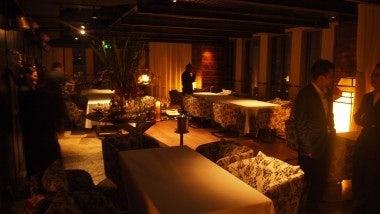
Ethan Tian, Food and Beverage Director:#
I think there is, because there’s scientific research [that] says the Asian palette is more sensitive than the Western palette. And also, I think wine is quite new to China and actually wine drinkers [here] like something more fruity and sweet to drink. The first time we did a blind tasting with 15 students, we had French Bordeaux and Burgundy, Australian wines...but didn’t tell them what was what. And actually, French wine came behind, with all of the New World wines coming first. A week later, they did another tasting, and at this one we told them which one was French, which one was Australian. This time, the French one came first. Exact same people, exact same wine.
So here, it’s more about mentality, Asian people sometimes like branding, so French wines, Bordeaux, Burgundy, should be top ones. But what I found out is that people enjoy drinking New World wines more, so that’s why our wine list is more focused on Australia, New Zealand, or even Chile. Also, now Bordeaux has become something to buy and sell, like the stock market, it’s not really for you to enjoy. Like last year, we were lucky to taste a bottle of 1959 Château Haut-Brion. It was stunning, but it cost 10,000 euros.
Julie:#
You wouldn’t be ordering that every week, would you.
Ethan:#
It's good, but is it worth 10,000 euros? I don’t think so. As Chinese people get more and more interested in wine, we're telling them, believe in yourself and trust in your own palette. Don't just believe in brand and price.
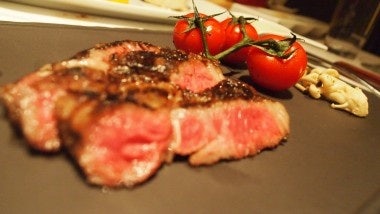
JD: What do you think of Chinese wines? Are there any you like?#
Ethan: We just attended a Chinese wine tasting the other day, with a boutique winery called Jade Valley. Julie’s going to be there this September. They produce Cabernet Sauvignon and Pinot Noir, and the owner is Qingyun Ma, a very famous architect. The first I'd heard of the winery was when Jancis Robinson (Ed. note: British wine critic) was quoted in a magazine as saying, “I just tasted this very interesting Pinot Noir from China called Jade Valley.” I was like, Pinot from China? My mind was blown.
We were very lucky to meet the owner and the winemaker and actually taste the wine, and I put their Cabernet Sauvignon on our wine list. There are pretty good quality Chinese wines, especially from small, boutique wineries coming up, they just need a bit of time.
Julie: And I think too, like you were saying, they’ve got a Californian winemaker behind them, teaching them how to make it, to the level that everyone’s used to. This makes sense, then, that it's a style everyone is accustomed to and will find acceptable.
Ethan:#
It's all about experience. You really have to know your game, it’s not just something you can just pick up. It really takes time. I think [China's] getting there. I just visited Tasmania, Australia, two weeks ago, and visited a very famous winemaker who consults a winery in China, and he said that within the next 20-30 years, China’s going to become a more [respected] winemaking country.
JD: This may be a better question for the bar upstairs, but mixologists and specialty cocktails have been a growing trend in the West. Do you see that kind of culture picking up in China? What's CHAR's signature drink?#
Ethan:#
Our main signature drink is the Char Tonic. It's Aperol -- sort of like Campari's little sister -- with a little bit of vermouth, Amaro, grapefruit, and a little bit of Tanqueray and tonic water. It’s very refreshing.
I think cocktails are more about taste. I know there are a couple of places opening in Shanghai that have molecular...or...gastronomic cocktails...
JD: Apothecary and the Alchemist. They do have pretty nice cocktails.#
Ethan:#
Yes, but I still think my favorite cocktail lounge in Shanghai is probably ours. The drinks are both classic and delicious.
Julie:#
I think people just want to be comfortable. You know, when you have a cocktail, you just want to be in a really nice cozy place, not in loud and bar-y or pub-y environment. That's how I feel about CHAR's cocktail lounge.
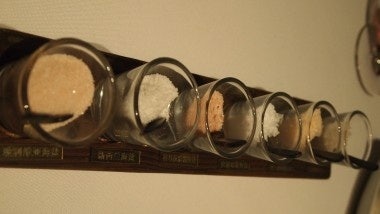
CHAR provides a selection of six fine natural salts
JD: How about the clientele here, what do you expect your clientele break-up to be like, expats to locals?#
Julie:#
I think 50-50, and even tonight you see it's probably 70-30, locals to foreigners.
JD: Is that something you're aiming for, to bring in more local Chinese? Or are you focusing on the foreign market?#
Julie:#
Yep, very much the Chinese market.
Ethan:#
Just from a business perspective, I think they’re your bread and butter, the Chinese. If you want to survive, as a restaurant, you need to get Chinese coming in, to really appreciate what you’re doing.
Julie:#
I think so. We talked a lot about this, how to make locals feel welcome and relaxed and not think, “this place is Western, it's full of expats, I don’t feel comfortable.” So yeah, I think this has been really important for us. And our team is made up of local Shanghainese as well. I’m the only one not from here so I learn a lot from them.
Teach me. (Laughs)
JD: So what is CHAR doing by way of marketing right now, inviting media?#
Julie:#
Yes. A lot of media, a lot of mini-launch parties. To be honest, a lot of word-of-mouth. For the three months that we were in soft opening, we hosted a lot of functions, so we welcomed many groups of people who are coming back now that we're open. We've had people, who after seeing us on a few media sources and blogs, come in to have a look. They want to see what it is. And again, we’re trying to really market ourselves not as a hotel restaurant but a stand-alone restaurant that happens to be on top of a hotel. We really want to try to get that out there, since people often make the association -- hotel restaurant, expensive. We’re different, so we’re trying not to connect the two if we can.
JD: Are you guys using any new media, social media?#
Julie:#
A lot of social media, yes. We've shown up on [local blogs like] EnjoyShanghai, SmartShanghai and others.
Ethan:#
In terms of social media, we’re going to get more involved on Facebook and more importantly, on Sina Weibo, the Chinese Twitter. I think, like when we have a group of Chinese people, when we do a wine-tasting, they get on Sina Weibo or Twitter, then suddenly more than 10,000 people know about it.
Julie:#
It’s amazing now.
Ethan:#
Yeah, we didn’t think that before.
Julie:#
Everything’s instant, isn’t it.
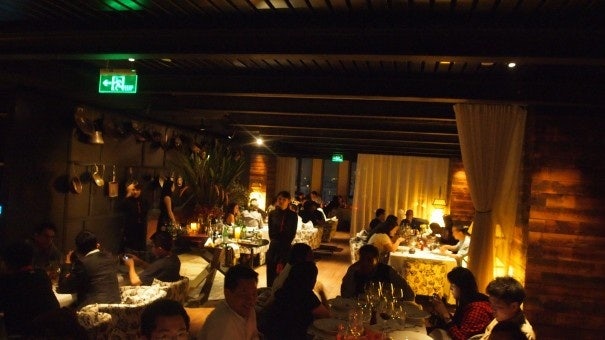
CHAR interior
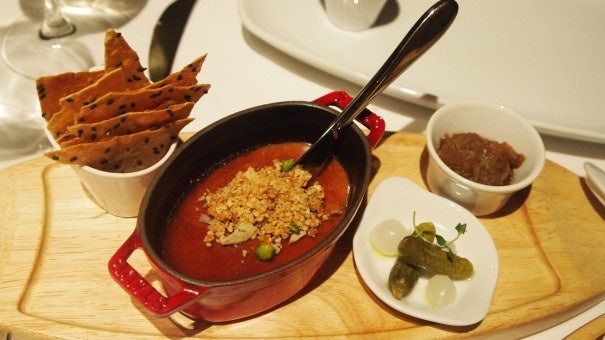
Fois gras with onion apple jam and pickled cornichons and pearl onions

Smoked salmon salad on a crispy hash brown
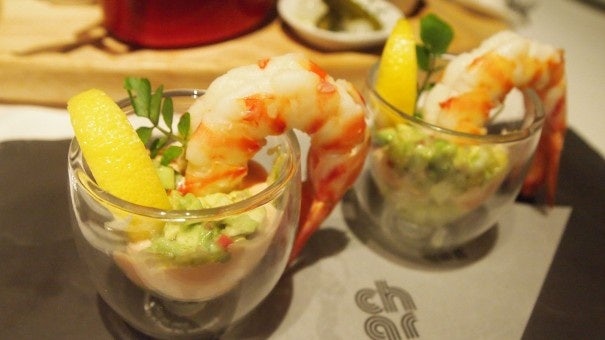
Shrimp salad with avocado, lemon and thousand island dressing
CHAR at Hotel Indigo on the Bund#
585 Zhongshan Dong Er Road (中山东二路585号)
Huangpu District, Shanghai (上海市黄浦区)
Reservations: +86 21 3302 9995
Website